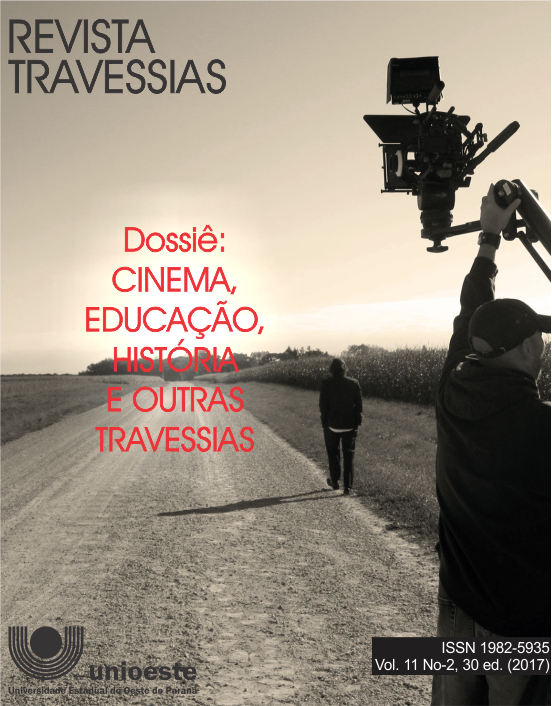Jane Austen in the 1940 silver screen: screwball comedy, translation and manipulation.
Keywords:
Jane Austen. Film. Translation. Politics.Abstract
This article aims at analyzing the adaptation of Pride and Prejudice, first published in 1813, by the English author Jane Austen, to the eponymous film directed by Robert Z. Leonard in 1940. In her work, Austen presents a love story, however it contains a complex narrative structure which reveals and provokes the questioning of sociopolitical problems of Edwardian England. Such questions stablish a dialogue with contemporary issues, such as values associated with social class, and the role of women in society. Nevertheless, it is considered that by being made into a film in the Hollywood cinema of the 1940s, the film narrative rewrites and projects another image of Austen and, therefore, of England. Consequently, erasing Austen’s criticism, and reinforcing a comic and romantic content. In this way, the following questions arose: what strategies were used in the adaptation and what are the consequences for Austen's work? As the main theoretical basis, it was used André Lefevere's (2007) concepts of translation as rewriting, and the studies of Patrick Cattrysse (1992), who conceives film adaptation as a type of translation. In addition, Wes D. Gehring’s (1983) studies about the film genre screwball comedy were used as well. The results confirm our hypothesis that the film narrative reinforces a romantic and comic content, as well as revealed that the film had a political function in its contexts of production and reception.Downloads
References
AUSTEN, Jane. Pride and Prejudice. London: Wordsworth Editions, 2007.
BENEDETTI, Ivone; SOBRAL, Adail (org.) Conversas com tradutores: balanços e perspectivas. São Paulo: Parábola Editorial, 2003.
BERGSON, Henri. O riso: ensaio sobre o significado do cômico. Traduzido da 375ª edição francesa. Rio de Janeiro, RJ: Editora Guanabara S.A., 1987.
CARTMELL, Deborah. Screen Adapations Jane Austen’s Pride and Prejudice: the relationship between text and film. London: metuem/drama, 2010.
CATTRYSSE, Patrick. Film (adaptation) as Translation: Some Methodological Proposals. In: Target – International Journal of Translations Studies. Amsterdam: John Benjamins Publishing Company, 1995. p. 53-70.
GHERING, Wes D. Screwball Comedy: defining a film genre. Muncie, Indiana: Ball State University, 1983.
GOMES, Paulo Emílio Salles. A personagem cinematográfica. In: CANDIDO, Antonio [et al]. A Personagem de Ficção. São Paulo: Perspectiva, 2011. p. 103-119.
JONES, Darryl. Critical issues: Jane Austen. New York: Palgrave Macmillan, 2004.
McFARLANE, Brian. Reading Film and Literature. In: CARTMELL, Deborah; WHELEHAN, Imelda. The Cambridge Companion to Literature on Screen. Cambridge, UK: Cambridge University Press, 2010. p. 15-28.
PARRILL, Sue. Jane Austen on Film and Television: a critical study of the adaptations. North Carolina: McFarland and Company, Inc., Publishers, 2002.
SILVA, C. A. V. A tradução cinematográfica de A Portrait of the Artist as a Young Man. Nonada Letras em Revista – Estudos da tradução, Porto Alegre, Vol. 1, nº 16, edição 812, p. 81 – 92, jan. –jun., 2011.
______. Mrs. Dalloway e a Reescritura de Virginia Woolf na Literatura e no Cinema. 2007. Tese (Doutorado em Letras e Lingüística) – Universidade Federal da Bahia, Salvador, 2007. p. 56 – 92.
TROOST, Linda V. The Nineteenth-century novel on film: Jane Austen. In: CARTMELL, Deborah; WHELEHAN, Imelda. The Cambridge Companion to Literature on Screen. Cambridge, UK: Cambridge University Press, 2010. p. 75-89.
TURAN, Kenneth. Pride and Prejudice: an informal history of the Garson-Olivier Motion Picture. In: http://www.jasna.org/persuasions/printed/number11/turan.html Acessado em: 01/10/2013.
CAPRA, Frank. Aconteceu Naquela Noite [It Happened One Night]. Com Clark Gable, Claudette Colbert, Walter Connoly. USA, 1934. 105 min.
FLEMING, Victor; CUKOR, George. E o Vento Levou [Gone with the Wind]. Com Clarke Gable, Vivian Leigh, Thomas Mitchell. USA, 1940. 238 min.
LEONARD, R. Z. Orgulho e Preconceito [Pride and Prejudice]. Com Greer Garson e Laurence Olivier. EUA, 1940. 118min.
Downloads
Published
How to Cite
Issue
Section
License
Creative Copyright Notice
Policy for Free Access Journals
Authors who publish in this journal agree to the following terms:
1. Authors keep the copyright and grant the journal the right of first publication, with the work simultaneously licensed under the Creative Commons Attribution License, which allows sharing the trial with acknowledgment of authorship and initial publication in this journal.
2. Authors are authorized to take additional contracts separately, for non-exclusive distribution of the work version, published in this journal (eg publish in institutional repository or as a book chapter), with acknowledgment of authorship and initial publication in this journal.
3. Authors are allowed and encouraged to publish and distribute their work online (eg in institutional repositories or on their personal page) at any point before or during the editorial process, as this can generate productive changes, as well as increase both impact and citation of the published trial (See The Effect of Free Access).
Creative Commons License
This work is licensed under a Creative Commons Attribution–NonCommercial-shareaswell 4.0 International License, which allows you to share, copy, distribute, display, reproduce, completely or part of the work, since there is no commercial purpose, and authors and source are cited.



